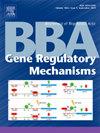Transcription factors associated with regulation of transcriptome in human thigh and calf muscles at baseline and after six days of disuse
IF 3.1
3区 生物学
Q3 BIOCHEMISTRY & MOLECULAR BIOLOGY
Biochimica et Biophysica Acta-Gene Regulatory Mechanisms
Pub Date : 2025-02-19
DOI:10.1016/j.bbagrm.2025.195086
引用次数: 0
Abstract
Disuse has a negative impact on the postural muscles of the trunk and legs. Different leg muscles demonstrate a differentiated and conservative response to disuse, in terms of a decrease in muscle mass, strength, aerobic performance, and changes in gene expression. We aimed to identify transcription factors regulating gene expression at baseline and after disuse in human m. soleus – a “slow” muscle with a strong postural function, and “mixed” m. vastus lateralis. Biopsies were taken from these muscles prior to and after 6 days of strict disuse (dry immersion). The enriched transcription factor binding sites (and corresponding factors) in the individual promoter regions of co-expressed genes were examined using the positional weight matrix approach. The baseline transcriptomic profiles and the disuse-induced changes (RNA-seq) differ significantly between muscles. In particular, the specific and significant response to disuse in m. soleus was found to be strongly related to the suppression of genes regulating the mitochondrial energy metabolism, the activation of the inflammatory response and the ubiquitin-proteasome system. This response is associated with the proinflammatory transcription factors such as families IRF, STAT, and other. The validity of approximately two-thirds of the predicted transcription factors was indirectly confirmed by the analysis of their function described in the literature. These identified transcription factors appear to be promising candidates for future targeted studies that mechanistically investigate gene expression regulation in various muscles at baseline, following disuse or inactivity.

在基线和停用6天后,与人大腿和小腿肌肉转录组调节相关的转录因子。
不使用对躯干和腿部的姿势肌肉有负面影响。在肌肉质量、力量、有氧运动表现和基因表达变化方面,不同的腿部肌肉表现出不同的和保守的废用反应。我们的目的是确定在人类比目鱼肌(一种具有强大姿势功能的“慢”肌肉)和“混合”股外侧肌中基线和废用后调节基因表达的转录因子。在严格弃用(干浸泡)之前和之后6 天,对这些肌肉进行活组织检查。利用位置权重矩阵法检测共表达基因的单个启动子区域中富集的转录因子结合位点(和相应的因子)。基线转录组谱和废用诱导的变化(RNA-seq)在肌肉之间有显著差异。特别是,比目鱼对废用的特异性和显著反应被发现与调节线粒体能量代谢的基因的抑制、炎症反应的激活和泛素-蛋白酶体系统的激活密切相关。这种反应与促炎转录因子如家族IRF、STAT等有关。大约三分之二的预测转录因子的有效性通过文献中描述的功能分析间接证实。这些已确定的转录因子似乎是未来有针对性的研究的有希望的候选者,这些研究将在基线、不使用或不活动后对各种肌肉的基因表达调控进行机制研究。
本文章由计算机程序翻译,如有差异,请以英文原文为准。
求助全文
约1分钟内获得全文
求助全文
来源期刊
CiteScore
9.20
自引率
2.10%
发文量
63
审稿时长
44 days
期刊介绍:
BBA Gene Regulatory Mechanisms includes reports that describe novel insights into mechanisms of transcriptional, post-transcriptional and translational gene regulation. Special emphasis is placed on papers that identify epigenetic mechanisms of gene regulation, including chromatin, modification, and remodeling. This section also encompasses mechanistic studies of regulatory proteins and protein complexes; regulatory or mechanistic aspects of RNA processing; regulation of expression by small RNAs; genomic analysis of gene expression patterns; and modeling of gene regulatory pathways. Papers describing gene promoters, enhancers, silencers or other regulatory DNA regions must incorporate significant functions studies.

 求助内容:
求助内容: 应助结果提醒方式:
应助结果提醒方式:


